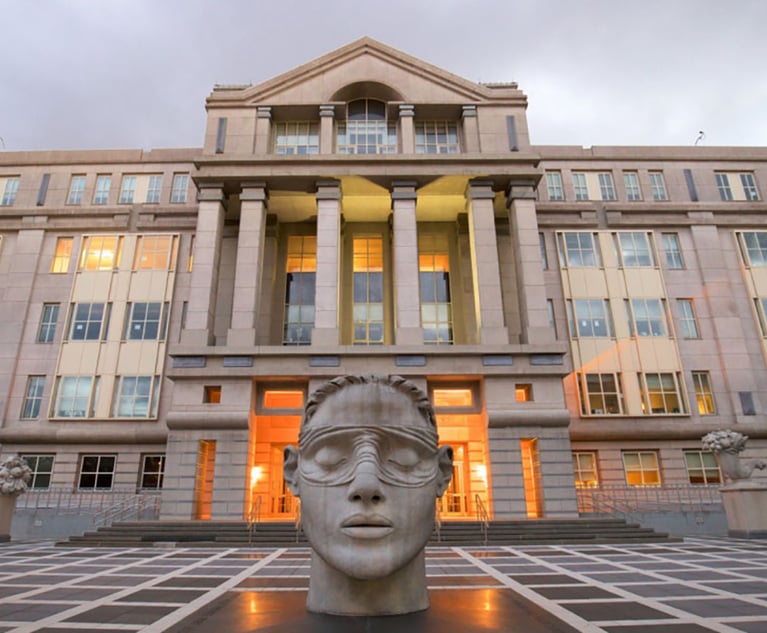 Bigstock
Bigstock Supreme Court Cameras Would Close the Circle
Now, more than ever, we believe that U.S. Supreme Court arguments, and all court proceedings, should be open to the public through video streaming or television.
January 09, 2022 at 10:00 AM
3 minute read
We have argued over many years that proceedings in the United States Supreme Court should be televised. Our argument was straightforward and, we think, persuasive. Court proceedings are public. In the twenty-first century, a proceeding is not truly "public" when only a hundred or so people can observe it in person in real time and the rest of us must rely on artists' renderings of the participants and journalists' accounts of what was said and done. An after-the-fact report filtered through the lens of another is never the same or as accurate or as objective as seeing it for ourselves.
The passing years, and especially the last two years of the pandemic, have only strengthened our position. First, the New Jersey Supreme Court has been live streaming oral arguments for some time now and we have heard nothing of abuses or interference with the solemnity of the proceedings. Second, since the pandemic forced a pause of in-person proceedings, the U.S. Supreme Court has been broadcasting audio of its arguments and that practice is continuing even now that the justices, counsel and a limited number of press representatives are attending arguments in person. Again, we have heard no reports of the audio broadcasts interfering with the proceedings or of snippets of the audio being taken out of context and leading to reports of the proceedings more misleading than otherwise. In our view, adding video to the broadcasts through live streaming or televising on C-Span or other similar outlets would cause no detriment and instead serve only to enhance the public's interest and understanding of our judicial process. While we do recognize that there are different considerations involved with the televising of jury trials in particular, we believe those concerns completely inapposite to appellate proceedings. We find it hard to imagine that Supreme Court advocates or justices would behave even at all differently simply because they were on camera. Finally, we think it must be acknowledged that the requirements of the pandemic have made video the expected mode of communication in business, in the legal profession and in society in general. The conference call has been largely replaced by the video meeting. We have video depositions, video trials and video oral arguments in state and federal trial courts across the country. The technology is available, affordable and easy to use. The only missing element is the will to use it. Now, more than ever, we believe that Supreme Court arguments, and all court proceedings, should be open to the public through video streaming or television.
This content has been archived. It is available through our partners, LexisNexis® and Bloomberg Law.
To view this content, please continue to their sites.
Not a Lexis Subscriber?
Subscribe Now
Not a Bloomberg Law Subscriber?
Subscribe Now
NOT FOR REPRINT
© 2025 ALM Global, LLC, All Rights Reserved. Request academic re-use from www.copyright.com. All other uses, submit a request to [email protected]. For more information visit Asset & Logo Licensing.
You Might Like
View All
'Younger and Invigorated Bench': Biden's Legacy in New Jersey Federal Court
5 minute read
Battles Won, Others Abandoned: 2024 Brought Big Change to the Judiciary
6 minute read
Will 2025 Bring a Change to Lawyers' Mandatory Pro Bono Duties Under 'Madden'?
7 minute read
Judges Push for Action to Combat Increasing Threats Against Judiciary
3 minute readTrending Stories
- 1African Law Firm Investigated Over ‘AI-Generated’ Case References
- 2Gen AI and Associate Legal Writing: Davis Wright Tremaine's New Training Model
- 3Departing Attorneys Sue Their Former Law Firm
- 4Pa. High Court: Concrete Proof Not Needed to Weigh Grounds for Preliminary Injunction Order
- 5'Something Else Is Coming': DOGE Established, but With Limited Scope
Who Got The Work
J. Brugh Lower of Gibbons has entered an appearance for industrial equipment supplier Devco Corporation in a pending trademark infringement lawsuit. The suit, accusing the defendant of selling knock-off Graco products, was filed Dec. 18 in New Jersey District Court by Rivkin Radler on behalf of Graco Inc. and Graco Minnesota. The case, assigned to U.S. District Judge Zahid N. Quraishi, is 3:24-cv-11294, Graco Inc. et al v. Devco Corporation.
Who Got The Work
Rebecca Maller-Stein and Kent A. Yalowitz of Arnold & Porter Kaye Scholer have entered their appearances for Hanaco Venture Capital and its executives, Lior Prosor and David Frankel, in a pending securities lawsuit. The action, filed on Dec. 24 in New York Southern District Court by Zell, Aron & Co. on behalf of Goldeneye Advisors, accuses the defendants of negligently and fraudulently managing the plaintiff's $1 million investment. The case, assigned to U.S. District Judge Vernon S. Broderick, is 1:24-cv-09918, Goldeneye Advisors, LLC v. Hanaco Venture Capital, Ltd. et al.
Who Got The Work
Attorneys from A&O Shearman has stepped in as defense counsel for Toronto-Dominion Bank and other defendants in a pending securities class action. The suit, filed Dec. 11 in New York Southern District Court by Bleichmar Fonti & Auld, accuses the defendants of concealing the bank's 'pervasive' deficiencies in regards to its compliance with the Bank Secrecy Act and the quality of its anti-money laundering controls. The case, assigned to U.S. District Judge Arun Subramanian, is 1:24-cv-09445, Gonzalez v. The Toronto-Dominion Bank et al.
Who Got The Work
Crown Castle International, a Pennsylvania company providing shared communications infrastructure, has turned to Luke D. Wolf of Gordon Rees Scully Mansukhani to fend off a pending breach-of-contract lawsuit. The court action, filed Nov. 25 in Michigan Eastern District Court by Hooper Hathaway PC on behalf of The Town Residences LLC, accuses Crown Castle of failing to transfer approximately $30,000 in utility payments from T-Mobile in breach of a roof-top lease and assignment agreement. The case, assigned to U.S. District Judge Susan K. Declercq, is 2:24-cv-13131, The Town Residences LLC v. T-Mobile US, Inc. et al.
Who Got The Work
Wilfred P. Coronato and Daniel M. Schwartz of McCarter & English have stepped in as defense counsel to Electrolux Home Products Inc. in a pending product liability lawsuit. The court action, filed Nov. 26 in New York Eastern District Court by Poulos Lopiccolo PC and Nagel Rice LLP on behalf of David Stern, alleges that the defendant's refrigerators’ drawers and shelving repeatedly break and fall apart within months after purchase. The case, assigned to U.S. District Judge Joan M. Azrack, is 2:24-cv-08204, Stern v. Electrolux Home Products, Inc.
Featured Firms
Law Offices of Gary Martin Hays & Associates, P.C.
(470) 294-1674
Law Offices of Mark E. Salomone
(857) 444-6468
Smith & Hassler
(713) 739-1250






